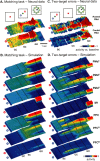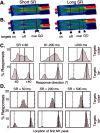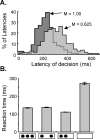Integrated neural processes for defining potential actions and deciding between them: a computational model
- PMID: 16988047
- PMCID: PMC6674435
- DOI: 10.1523/JNEUROSCI.5605-05.2006
Integrated neural processes for defining potential actions and deciding between them: a computational model
Abstract
To successfully accomplish a behavioral goal such as reaching for an object, an animal must solve two related problems: to decide which object to reach and to plan the specific parameters of the movement. Traditionally, these two problems have been viewed as separate, and theories of decision making and motor planning have been developed primarily independently. However, neural data suggests that these processes involve the same brain regions and are performed in an integrated manner. Here, a computational model is described that addresses both the question of how different potential actions are specified and how the brain decides between them. In the model, multiple potential actions are simultaneously represented as continuous regions of activity within populations of cells in frontoparietal cortex. These representations engage in a competition for overt execution that is biased by modulatory influences from prefrontal cortex. The model neural populations exhibit activity patterns that correlate with both the spatial metrics of potential actions and their associated decision variables, in a manner similar to activities in parietal, prefrontal, and premotor cortex. The model therefore suggests an explanation for neural data that have been hard to account for in terms of serial theories that propose that decision making occurs before action planning. In addition to simulating the activity of individual neurons during decision tasks, the model also reproduces key aspects of the spatial and temporal statistics of human choices and makes a number of testable predictions.
Figures







Comment in
-
A new unified framework for making and implementing decisions.J Neurosci. 2006 Dec 20;26(51):13121-2; discussion 13121. doi: 10.1523/jneurosci.4758-06.2006. J Neurosci. 2006. PMID: 17186625 Free PMC article. Review. No abstract available.
Similar articles
-
Cortical mechanisms of action selection: the affordance competition hypothesis.Philos Trans R Soc Lond B Biol Sci. 2007 Sep 29;362(1485):1585-99. doi: 10.1098/rstb.2007.2054. Philos Trans R Soc Lond B Biol Sci. 2007. PMID: 17428779 Free PMC article.
-
Reward-dependent learning in neuronal networks for planning and decision making.Prog Brain Res. 2000;126:217-29. doi: 10.1016/S0079-6123(00)26016-0. Prog Brain Res. 2000. PMID: 11105649 Review.
-
A biologically plausible computational theory for value integration and action selection in decisions with competing alternatives.PLoS Comput Biol. 2015 Mar 24;11(3):e1004104. doi: 10.1371/journal.pcbi.1004104. eCollection 2015 Mar. PLoS Comput Biol. 2015. PMID: 25803729 Free PMC article.
-
Movement-related activity during goal-directed hand actions in the monkey ventrolateral prefrontal cortex.Eur J Neurosci. 2015 Dec;42(11):2882-94. doi: 10.1111/ejn.13040. Epub 2015 Sep 21. Eur J Neurosci. 2015. PMID: 26262918
-
A parallel framework for interactive behavior.Prog Brain Res. 2007;165:475-92. doi: 10.1016/S0079-6123(06)65030-9. Prog Brain Res. 2007. PMID: 17925265 Review.
Cited by
-
Heterogeneous attractor cell assemblies for motor planning in premotor cortex.J Neurosci. 2013 Jul 3;33(27):11155-68. doi: 10.1523/JNEUROSCI.4664-12.2013. J Neurosci. 2013. PMID: 23825419 Free PMC article.
-
Vacillation, indecision and hesitation in moment-by-moment decoding of monkey motor cortex.Elife. 2015 May 5;4:e04677. doi: 10.7554/eLife.04677. Elife. 2015. PMID: 25942352 Free PMC article.
-
Content-specific evidence accumulation in inferior temporal cortex during perceptual decision-making.Neuroimage. 2015 Apr 1;109:35-49. doi: 10.1016/j.neuroimage.2014.12.072. Epub 2015 Jan 3. Neuroimage. 2015. PMID: 25562821 Free PMC article.
-
Computation Through Neural Population Dynamics.Annu Rev Neurosci. 2020 Jul 8;43:249-275. doi: 10.1146/annurev-neuro-092619-094115. Annu Rev Neurosci. 2020. PMID: 32640928 Free PMC article. Review.
-
Neural correlates of a postponed decision report.Proc Natl Acad Sci U S A. 2007 Oct 23;104(43):17174-9. doi: 10.1073/pnas.0707961104. Epub 2007 Oct 16. Proc Natl Acad Sci U S A. 2007. PMID: 17940014 Free PMC article.
References
-
- Bhushan N, Shadmehr R. Computational nature of human adaptive control during learning of reaching movements in force fields. Biol Cybern. 1999;81:39–60. - PubMed
-
- Bock O, Eversheim U. The mechanisms of movement preparation: a precuing study. Behav Brain Res. 2000;108:85–90. - PubMed
-
- Boynton GM. Attention and visual perception. Curr Opin Neurobiol. 2005;15:465–469. - PubMed
-
- Carello CD, Krauzlis RJ. Manipulating intent: evidence for a causal role of the superior colliculus in target selection. Neuron. 2004;43:575–583. - PubMed
Publication types
MeSH terms
LinkOut - more resources
Full Text Sources
Other Literature Sources
